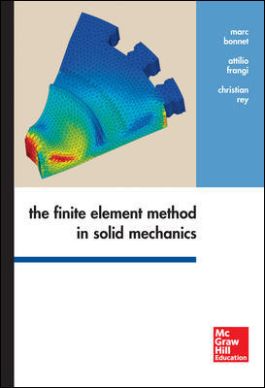THE FINITE ELEMENT METHOD IN SOLID MECHANICS
1ed
8838674469
·
9788838674464
© 2014 | Data di Pubblicazione: 5 Settembre 2014
The book focuses on topics that are at the core of the Finite Element Method (FEM) for the mechanics of deformable solids and structures.Its main objective is to provide the reader, who is assumed to be familiar with standard continuum solid mechanic…
Continua a leggere
1. Elastic equilibrium problems and their approximate solution
2. Isoparametric elements
3. The finite element method for linear problems
4. Transien theat conduction and linear thermoelasticity
5. Dynamical analysis of elastic solids
6. Penalty approaches, mixed formulations
7. Application to linear elastic fracture mechanics
8. Introduction to nonlinear solid mechanics. Nonlinear elasticity
9. Numerical elastoplasticity
2. Isoparametric elements
3. The finite element method for linear problems
4. Transien theat conduction and linear thermoelasticity
5. Dynamical analysis of elastic solids
6. Penalty approaches, mixed formulations
7. Application to linear elastic fracture mechanics
8. Introduction to nonlinear solid mechanics. Nonlinear elasticity
9. Numerical elastoplasticity
The book focuses on topics that are at the core of the Finite Element Method (FEM) for the mechanics of deformable solids and structures.
Its main objective is to provide the reader, who is assumed to be familiar with standard continuum solid mechanics, with a clear grasp of the essentials, sufficient background for reading and exploiting the research literature on computational solid mechanics, and a working knowledge of the main implementational issues of the FEM.
This book arises from a course taught since 2004 to last-year students of Ecole Polytechnique (France). It is intended for Master and PhD students, as well as scientists and engineers looking for a rigorous introduction to FEM theory and programming for linear and non-linear analyses in solid mechanics.
As a distinguishing feature, in addition to sections devoted to theory and concepts presented in general terms, each chapter also features other sections (interspersed with the former) devoted to detailed description of specific features (e.g. the construction of a specific finite element), annotated Matlab code and/or numerical examples produced with it, or worked-out analytical examples.
Its main objective is to provide the reader, who is assumed to be familiar with standard continuum solid mechanics, with a clear grasp of the essentials, sufficient background for reading and exploiting the research literature on computational solid mechanics, and a working knowledge of the main implementational issues of the FEM.
This book arises from a course taught since 2004 to last-year students of Ecole Polytechnique (France). It is intended for Master and PhD students, as well as scientists and engineers looking for a rigorous introduction to FEM theory and programming for linear and non-linear analyses in solid mechanics.
As a distinguishing feature, in addition to sections devoted to theory and concepts presented in general terms, each chapter also features other sections (interspersed with the former) devoted to detailed description of specific features (e.g. the construction of a specific finite element), annotated Matlab code and/or numerical examples produced with it, or worked-out analytical examples.

